In the 1990s, the US Navy found itself at a loose end, as the missions that had defined the late Cold War faded in importance and it reoriented itself towards land attack. The main result was a new destroyer, designed primarily to provide fire support for troops ashore, but with some multi-mission capability. Unfortunately, they decided that this class would be truly stealthy, which drove up size and trapped the ships in a spiral of increasing cost and falling numbers, with a 32-ship program being cut to only three ships by 2008, and coming close to being shut down in 2010 thanks to the resulting cost increases.
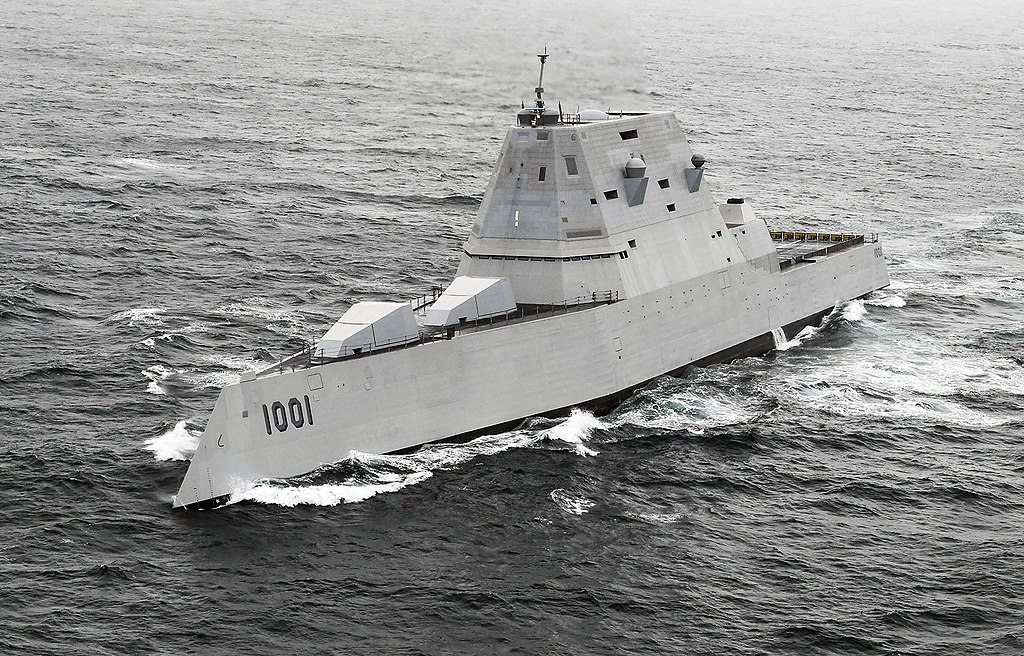
USS Michael Monsoor
The first ship, USS Zumwalt (DDG-1000)1 was ordered in 2008, and followed by Michael Monsoor, named for a SEAL killed in Iraq, and Lyndon B Johnson, named for an obscure naval officer who served briefly in WWII. The three ships were laid down in 2011, 2013 and 2017 respectively, but the start of construction did little to slow the cost growth, as the combined procurement cost of the three ships rose from $9 billion in FY09 to $13.3 billion in FY21, not counting R&D costs of something like $10 billion.2 The program's weirdness continued as the ships neared completion. Instead of integrating the weapons and then accepting and commissioning the ships, the first two units were officially commissioned in 2016 and 2019, and then sent to San Diego for weapons integration. Zumwalt finally completed this process in 2020, although initial operational capability has continued to slide, and is currently scheduled for Q4 2024.
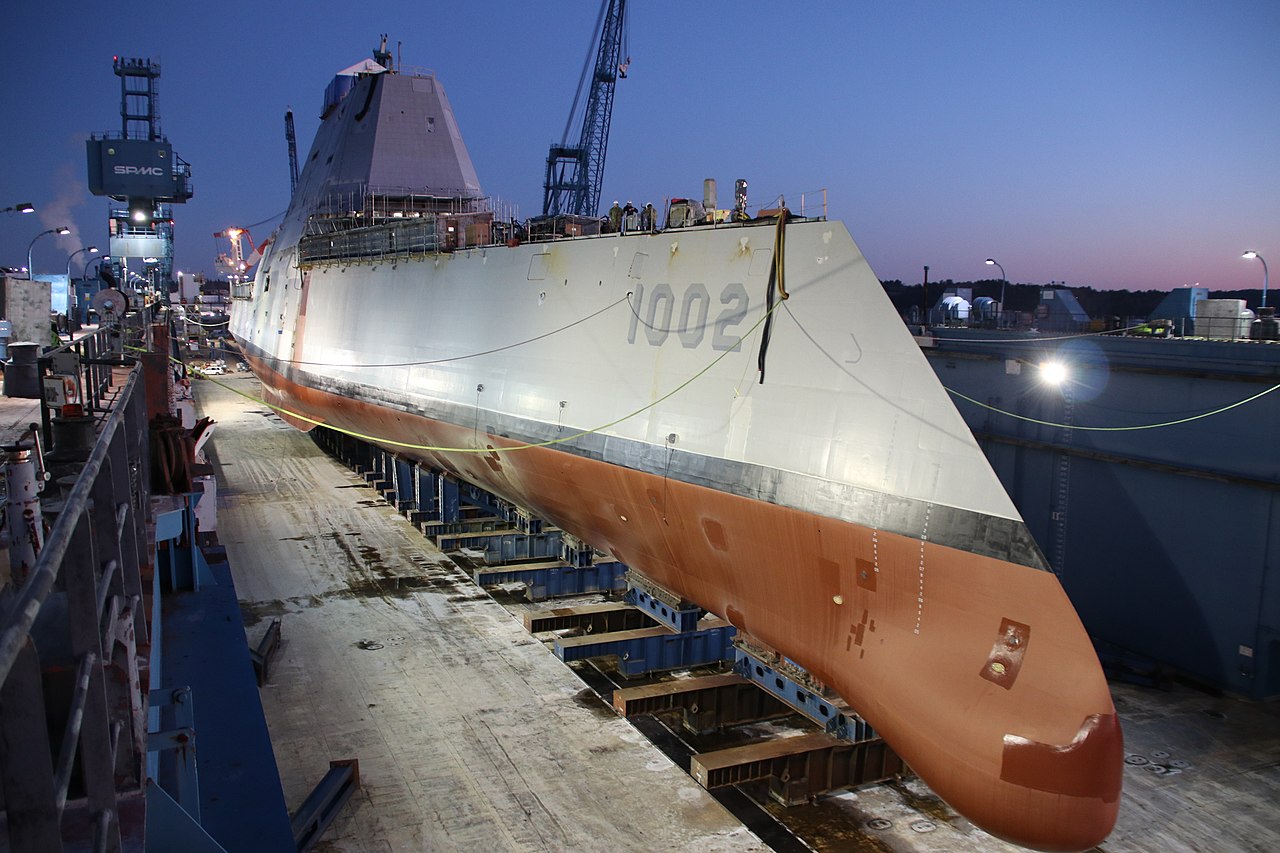
USS Lyndon B. Johnson under construction
So what was the result of all this? A 15,500 ton "destroyer" that, while it may have confounded some of its harshest critics by not tipping over on trials,3 is of extremely questionable utility in this day and age. The two 155 mm AGSs were designed primarily to fire the Long Range Land Attack Projectile (LRLAP), at a rate of 10 rounds a minute each and to a range of about 80 nm, far outranging the 16"/50 guns they were supposed to replace. However, costs spiraled out of control, and in 2016 the Navy announced that it was scrapping the LRLAP instead of paying $800,000-$1 million for each round. There has been some discussion of trying to find a replacement projectile, probably an existing 155 mm round, but nothing official. It appears that there are no technical reasons this couldn't be done, but the fact that only three ships are planned to carry the AGS makes spending more money on them fiscally dubious.
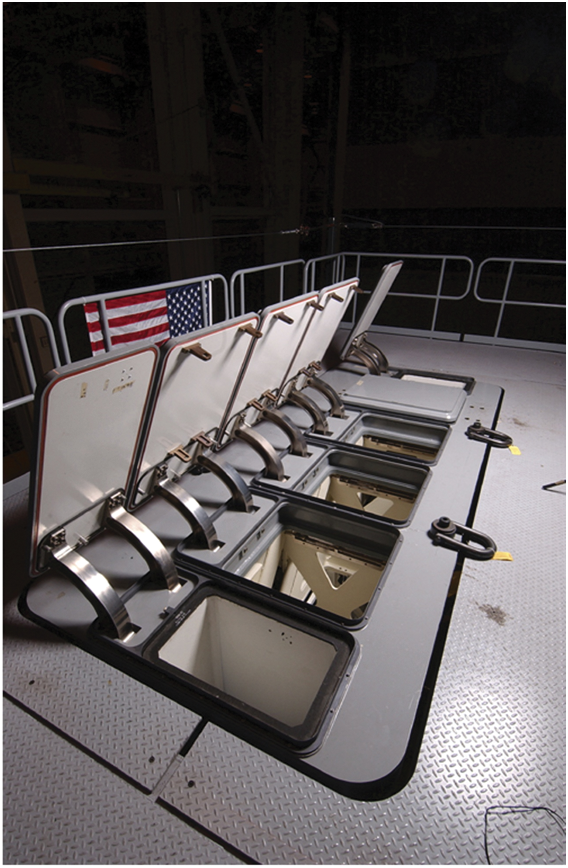
Mk 57 VLS
Nor did the armament problems stop there. The Zumwalts were originally intended to have a pair of Mk 110 57 mm guns, as used on the LCS, as secondary armament. However, analysis in 2012 led the Navy to discard these and replace them with much smaller and lighter 30 mm guns, which it was claimed were significantly more effective. At least the 80-cell VLS works reasonably well, although the new ships use a new Mk 57 module scattered around the edges of the deck, instead of the central nest of Mk 41s used on the Burkes and Ticos. These have somewhat larger cells than the Mk 41, and are able to handle significantly higher exhaust flows, but these capabilities are unlikely to be used for a long time, given the number of Mk 41s in the fleet. So far, the missile fit seems to be limited to Tomahawk, Standard and ESSM, with no reported capability to handle VL-ASROC.4 The hangar built into the superstructure can accommodate two SH/MH-60 helicopters. Underneath the flight deck is the internal hangar for the ship's boats, which are deployed through a door in the stern. The sonar suite is optimized for shallow-water ASW and mine avoidance and like so many other systems is unique to the Zumwalts.
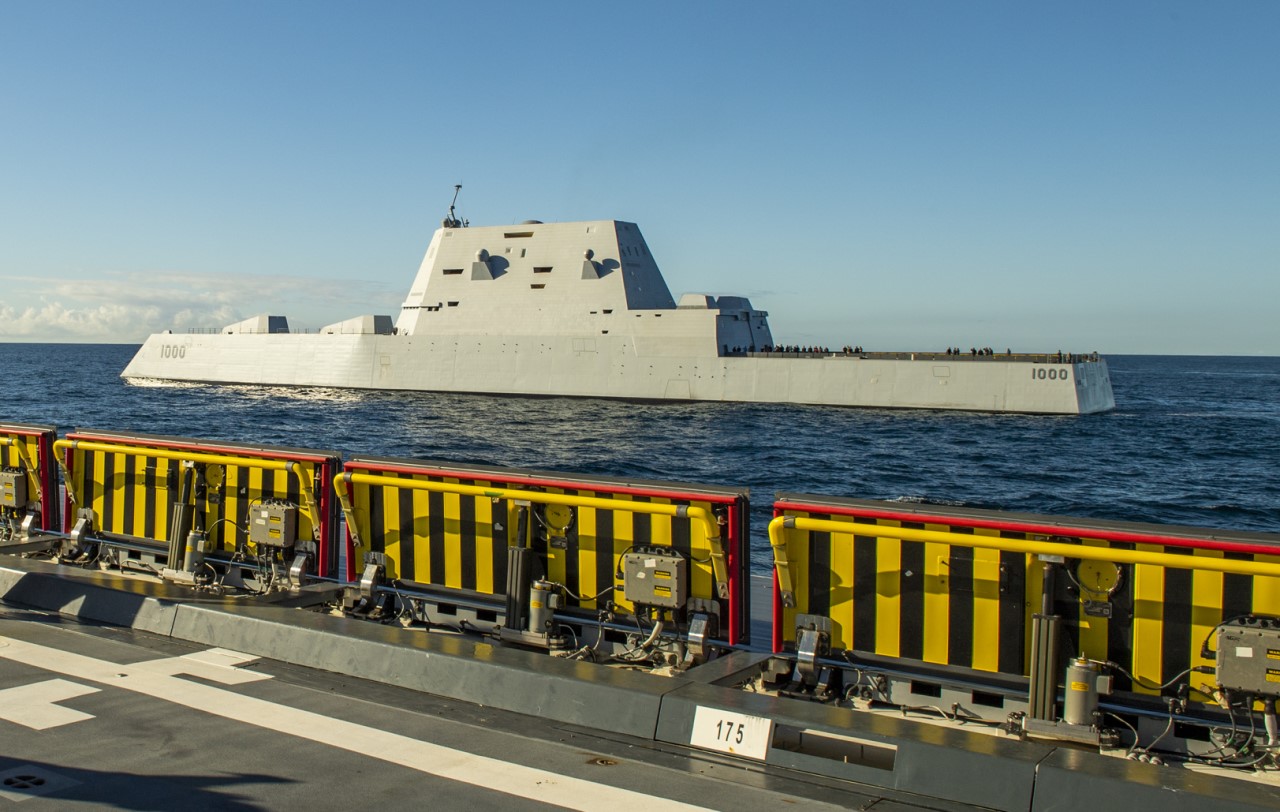
Zumwalt from Monsoor. Note the railings, which are retractable for reduced RCS
And the unique nature of the ships has not helped things as they've moved closer to service. In late 2017, the Navy noticed that the original mission of its shiny new destroyers didn't make sense, thanks to changing strategic circumstances and the lack of LRLAP. Instead, it was decided that the new ships would be tasked with surface strike, using missiles against both ships and surface targets. Of course, this required an anti-ship missile, which the USN is short on. Harpoon is right out, because the standard launchers would wreck the ship's stealth (not to mention a lack of places to put them), while Tomahawk doesn't have great anti-ship capability and LRASM doesn't seem to be in vertical-launch form yet. In practical terms, the change in missions seems like it was primarily a way for the Navy to pretend that they didn't spend billions of dollars on ships that are essentially useless in combat. The current plan is to remove the AGS and install a dozen of the imaginatively-named Long-Range Hypersonic Weapon, although this has been delayed from 2025 to 2027, and it's not clear if they will work any better than anything else connected to the Zumwalt.
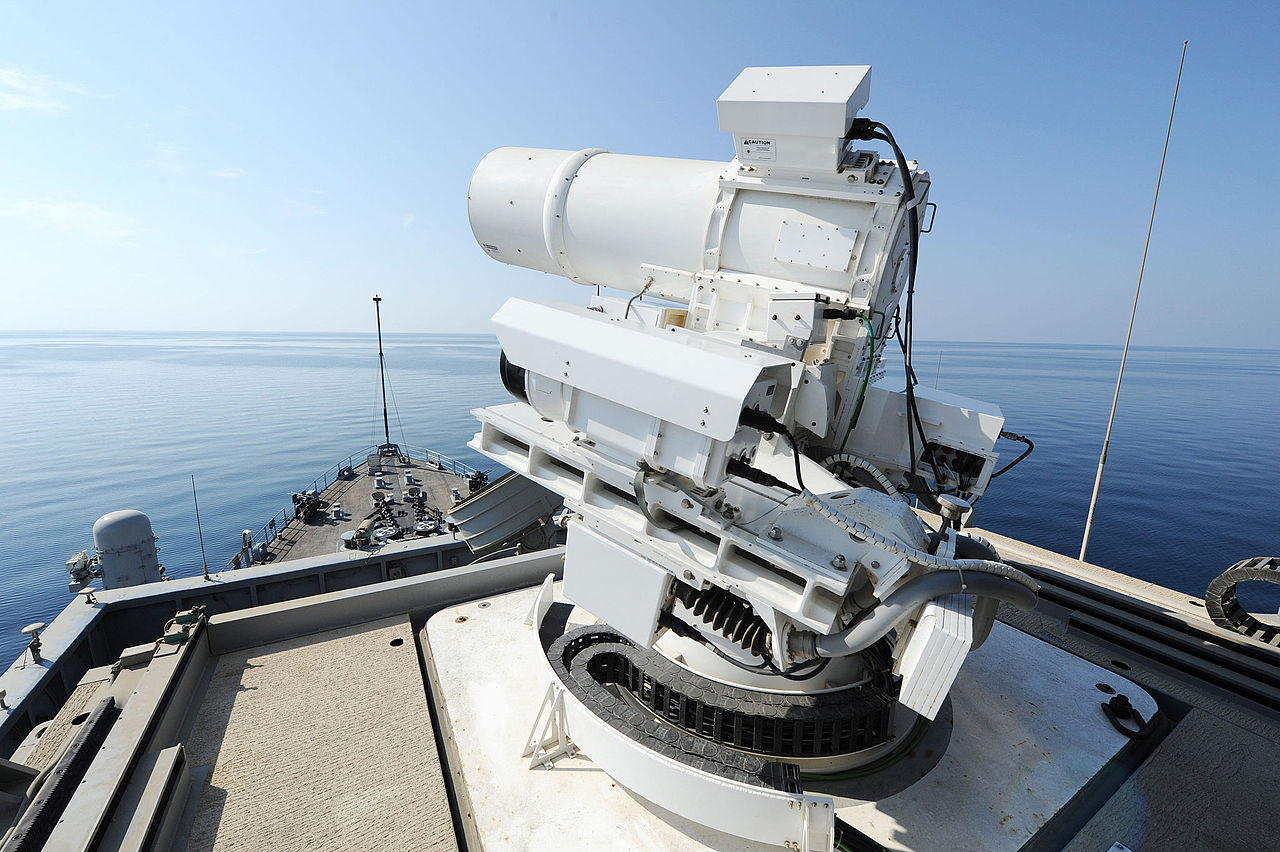
A laser aboard USS Ponce
But that doesn't mean they're entirely useless everywhere. The one thing that the Zumwalts bring which no other American ship has is massive electrical reserves. The integrated electric propulsion system, driven by a pair of gas turbines, provides a total of about 78 MW of electrical power, which is likely to become increasingly important as advanced weapons like railguns and lasers begin to enter service over the next decade or two. They'll need testing at sea, and "advanced" ships that are of little use to the fleet and have lots of power are perfect. The only real drawback is that the Navy will probably feel the need to maintain the pretense that they're still stealthy, operational ships, and that will restrict the systems they can add. That said, the Navy recently fitted the ships with conventional satellite antennas, which probably increased RCS somewhat. This may be a result of increasing understanding of the inherent limitations of surface ship stealth, as a vessel with the radar signature of a fishing boat still produces a very detectable wake, which modern signal processing can pick up. The Zumwalts also have the potential to advance the state of the art in other areas, such as the new propulsion system and in reducing manning, as they have about half the crew of a Burke. That said, the lesson there appears to be that while the USN may overman its ships, the Zumwalt has gone too far in the other direction.
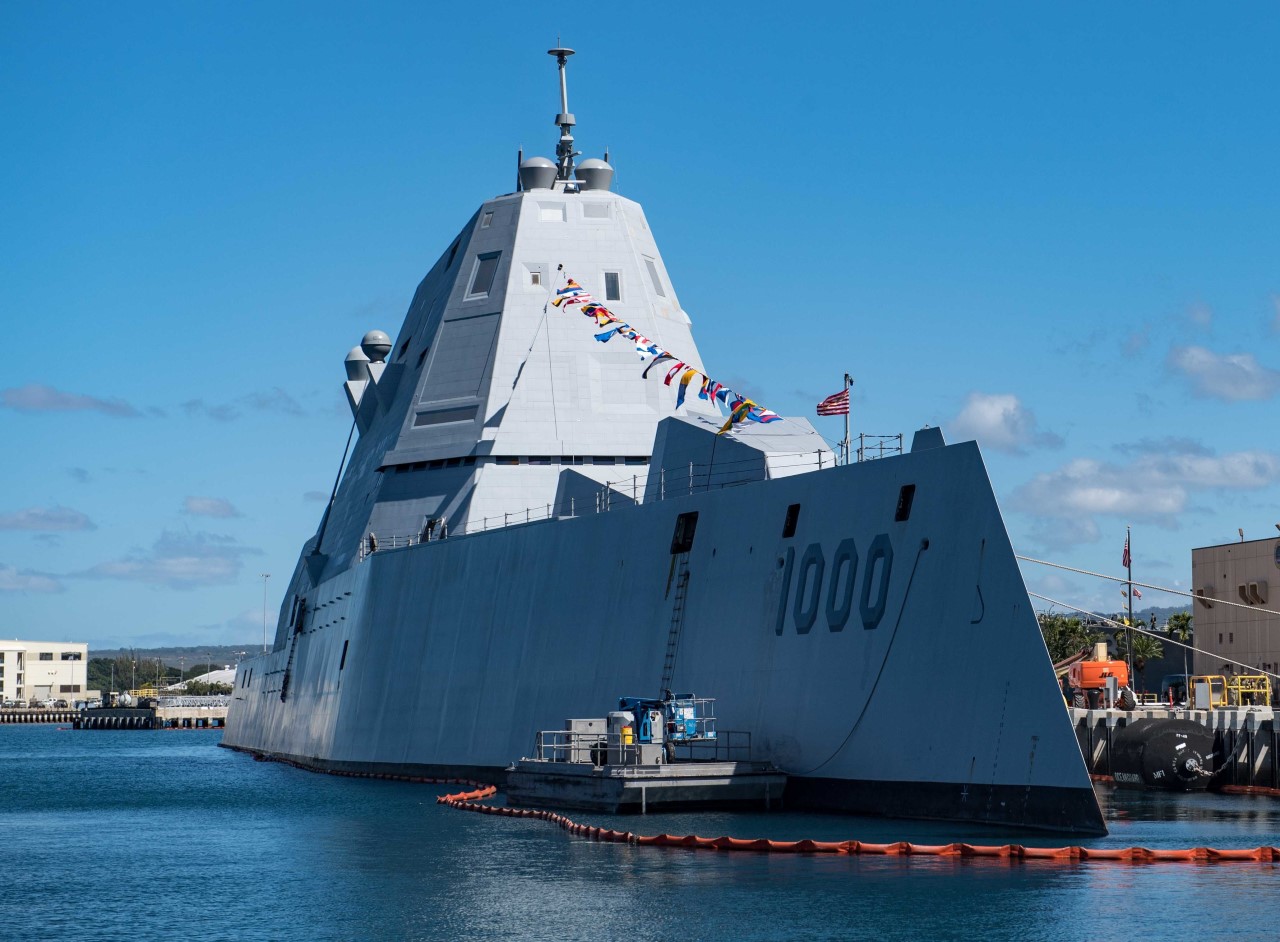
Zumwalt shows external satellite antennas during a 2019 visit to Pearl Harbor
But even a look at their benefits shouldn't be taken to mean that the Zumwalt class was anything other than a colossal waste of taxpayer money, funds that would have been better spent on upgrades to the Burke class. Indeed, the entire thing was such a disaster that it was replaced by further Burkes, and while a new follow-on is in work, it is still uncertain when it will finally take to the water. Ultimately, we have a trio of white elephants that will probably make themselves useful, but will in no way be worth their cost.
1 This designation makes very little sense. The DD and DDG sequences have been separate, except for the Kidd class ships, which were numbered in the DD series, which ultimately reached DD-997. Putting the Zumwalts in the DD series makes some sense given the lack of area air-defense system, but the Navy chose for some reason to give them DDG designations. At least they weren't given hull numbers starting at DD-21, as was done for the Seawolf class submarines, which started with SSN-21. On the other hand, someone probably pointed out that hull numbers would start to overlap with the Burkes if the original buy was carried out. The lesson from all of this is that doing stupid things with your hull codes dooms your class to only have three ships. ⇑
2 I'm not sure exactly what year these costs are baselined to. In any case, they're horribly excessive, and the program really should have died in 2010. ⇑
3 There was serious concern that the tumblehome on the hull would dramatically reduce stability, which seem to have been laid to rest during sea trials. ⇑
4 I originally thought that they didn't have Standard, but ran across a reference to a special version of the SM-2 for the Zumwalt. ⇑

Comments
Am I reading this correctly? They don't currently have a working gun?
That is correct. Two fancy newfangled guns per ship, no shells for them anywhere, no blueprints for a shell that we could send to a factory and say "we need a thousand of these ASAP". They can't even fire the shells from the Army's 155mm howitzers.
So is Johnson just sending a signal that LBJ will never get a carrier?
The Rolls-Royce MT30 seems to be having a lot of success. Do you think it'll be in the running for powering the Burke replacements?
I'm curious about the actual power usage underway. The Zums have a significantly more efficient hullform than the Burkes, so my rules of thumb are kinda broken.
I saw a comment suggesting they use 10MW at "cruising speed", which means they could run on a single MT30 with 25MW for ship systems... which seems kinda high, given they're not running Aegis (which is, what, 6MW?). It also means they're not just cruising on the small turbines.
Could they just be running a single turbine at half output most of the time?
@echo
There would be a certain justice in the Great Debaser getting short-changed.
Well, Johnson has a ship named after him, and the USN has never, IIRC, named two ships after the same person at the same time.
Current rumor is that the Burke replacement will use the Zumwalt propulsion system.
They could be. No reason to keep both turbines hot if you only need one, because that wastes fuel. That said, if they cruise on 50% of one turbine, I'm surprised that the MT30 was picked alone. It must be really efficient at half throttle to make that work.
@echo,
So is Johnson just sending a signal that LBJ will never get a carrier?
It certainly seems like it - or possibly even a pre-emptive move to block an anticipated attempt to name a CV for Outhouse Bomber Johnson.
Similarly USS Jimmy Carter.
Maybe they just cruise the zums around at 25knts? That plus hotel loads seems like it'd use roughly a full turbine, with the others for pushing that last 8knts and making pew pew pretend railgun noises?
What's stopping them? Don't they all fit into the same VLS cells? Would it need a special radar or something for the other missiles?
It's an integration problem, not a physical one. Essentially, the Navy hasn't done the work necessary to make Standard and VLASROC talk to the Zumwalt combat system. At least for Standard, that's probably because they don't really have the right radar to use it well. I know this sounds easy, but it really isn't.
"and in 2016 the Navy announced that it was scrapping the LRLAP instead of paying $800,000-$1 million for each round."
Even knowing that all advanced kit does not come cheaply, a million large a round should make any taxpayer wince. A minutes worth of firing comes with a bill for 10 mil and pretty soon, in the spirit of Adlai Stevenson, and we are talking about real money.
But as John so aptly stated, being left with nothing doesn't seem very wise either. Not even a contingency order plan?
Could they take the guns out and replace them with boring old models of 155mm guns that fire standard ammunition?
If the USN overmans their ships, why are the crews so terrifically overworked?
How much was the marginal cost of a zumwalt hull in 2010? Was it that much higher than burke flight IIA?
@Ian Argent
Parkinson's law: Work expands to fill the amount of time available for its completion.
Re replacing the guns, it's probably not going to happen. They'd have to start from scratch, and even integrating an Army 155mm gun would be surprisingly expensive and time-consuming, for a capability that isn't that far beyond what we can get from existing 5" guns.
@Ian
Overmanning in this context is using people to do work that other navies have automation to do. So there's more work needed aboard an American ship, and it wouldn't be the first time they had underestimated how many people they needed. The Spruances saw their crews grow substantially in their first years in service. Add in extra administrative paperwork, and you get what we saw aboard McCain and Fitzgerald.
@cassander
No idea offhand. I still think the whole program should have died, but a Burke is definitely a more useful ship, so even if the marginal cost is the same, that's the one to buy.
@cassander The conditions that lead to the recent accidents suggest that work has expanded past the crew-hours available at a sane schedule. I don't think we can explain it with just Parkinson's Law.
With respect to the Mk 57's location, I think that is a good idea. Tanks use explosive/reactive armor, is there a reason it wouldn't work on a ship?
With respect to the naming, I am glad LBJ isn't getting a CV named after him. Personally, I hate how the USN is naming CV's after Presidents; Ford being the most egregious. Carriers need to be named after famous ships like the Enterprise, Essex, Lexington, Hornet, etc IMHO.
The boring old 155mm guns that fire the shells we have millions of, have to be manually loaded and assume the crew has a reasonable amount of room to work with ammunition conveniently available "at grade". Also, they use bagged charges which the navy hasn't used in decades. Fitting those gun tubes into a Zumwalt's stealthed gun mounts, with the machinery to turn ammunition from a below-decks magazine to shells on target at a high sustained firing rate, would require a lot of expensive engineering, development, and testing that the Navy doesn't want to pay for.
And it would require officially admitting that their fancy 100-mile guided supershells are completely dead, whereas they can now dream that maybe someday that program will be resurrected.
In hindsight, they should have designed the guns with a dual feed that could load either Navy supershells or dumb Army shells, but that was just one of many bad decisions on this program
@John Schilling
Wouldn't a dual shell system be a signed invitation to congress to cancel the super-shell system?
@2021Rabidchaos
More people means they need to do more work to keep them busy, which means more work that needs to be monitored and more forms that need to be filled out, but there's still only one captain and one XO, so things start to slip. Parkinson's law isn't why the situation got so bad, but it is a big part of why it's hard to fix, because all of those people feel vital and important, even if those last few guys aren't a net benefit.
@johnschilling
We could take the AGS turret out and weld a paladin to the deck in its place. Sure it's not a GOOD solution, you might even call it a silly solution, but it's less silly than having guns with no ammunition...
On conventional 155mm guns:
From 2004, the RN had a project to adapt the 155mm gun from the British Army's existing AS-90 self-propelled howitzer to fit on their existing Mk 8 Mod 1 4.5" gun mountings.
This was cancelled in 2010, partly because of budget cuts. There may also have been issues because the AS-90 was being upgraded at the same time. The naval project used the upgraded "Braveheart" gun, but IIRC the upgrade was cancelled because of problems with the modular (not bagged) charges.
@cassander- Perhaps closer to "welding a Paladin to the deck" than the RN's 155mm project, the German MONARC project involved mounting the complete turret of their PzH 2000 howitzer on a frigate. This weighed the same as the existing 76mm turrets, but needed a special flexible mount to cope with the increased recoil. Predictably, it ran into corrosion problems...
I see a lot of problems with welding a Paladin to the deck. First, I'm not sure what it gets you. You'll need to do a lot of work to make it able to accurately hit targets, and there's not that much of an advantage over the exiting 5" guns. The AGS could justify itself with much greater range, but that isn't true of the Paladin. Second, I don't think a Paladin is rated to survive the upper deck of a Zumwalt. Note that the wave-piercing bow means the deck is often covered in water. This is not a major design consideration for a self-propelled howitzer, and it will rust out in no time. Third, there's all the weird integration issues you'd have to deal with. I've heard about several plans, including MONARC, and they keep failing. Let's just stop throwing good money after bad, and treat the AGS as a space and weight reservation for lasers or railguns.
I'd really love to hear more about their seakeeping, but there doesn't seem to be that much public info about it yet. I'm having trouble even finding video of them with the deck awash.
You could make up for accuracy problems by increasing the volume of fire. I propose that several rows of gunports be added to each side of Zumwalt.
@Lambert: Zumwalt is about the size of a pre-dreadnought battleship, and the standard armament of a pre-dreadnought included 6-8 quick-firing 6" guns on each broadside, so you may be on to something here. Onward to the 19th century!
Bean, can we find an excuse to fit her with a ram?
The wave-piercing bow is already pointy, so we're part of the way there. We "only" need to reinforce it so it's sturdy enough that you can still use the ship after ramming something.
A ramming capability would dovetail nicely with a stealth design: the hard part of ramming in a modern context is getting close enough to ram without getting killed, and stealth should help with that. Almost certainly not enough, though, since long before you're in position to ram you're taking direct fire over open sights no matter how good your stealth is. Also, just about anything a ram could do can be done better with a torpedo tube or two.
A ram is ridiculous. No ship has been rammed in naval conflict since... (checks notes) April 2020...
I don't think fitting the ship with a ram would actually help that kind of ramming, where the point is far more to annoy the other ship than to actually damage it. That, or you're thinking of something very different than I am.
@Eric Rall: Well, if your adversary is the 7th fleet, you can definitely get within ramming distance before they notice you.
But, between that and the April 2020 incident, you're right that we don't need to be putting rams on modern warships. The rams are for merchant vessels that have to operate in the same waters as clueless idiots with modern warships. RCGS Resolute managed with just an icebreaking bow, but not everybody has those.
Still, with the Zumwalt's magazines and half her VLS cells empty, it's debatable whether she counts as a warship so we can give her a ram to level the playing field :-)
"Army's dumb shells"
https://en.wikipedia.org/wiki/M982_Excalibur - "Versions that add laser-guidance capability and are designed to be fired from naval guns began testing in 2015"
And the ERCA program is working up a 155 mm cannon (58 caliber instead of the current 39 caliber) to hit targets at 70+ km https://www.army.mil/article/244447/picatinnysextendedrangecannonartilleryautoloaderbegins_testing
The bagged charges thing is a problem, but surely could be engineered around?
My first thought on how to work around the bagged charges problem is to design a brass cartridge instead. You'd probably want a bigger propellant charge to account for the longer barrel anyway.
I'm not sure whether the economics of CLGPs as an upgrade to existing guns work out the same as making a brand-new supergun boondoggle.
Making a few Excaliburs for when you really need extreme range or precision fire vs exclusively firing LRLAPs. And the everpresent question of how it compares to a missile.
@Lambert: I was thinking about ways to rescue SOME sort of usability for the Zumwalkt's main gun.
What is stopping you from just using an army SP-art from the flight deck? That would be at least as practical as anything else on that ship.
Generally speaking, the Army's gear isn't specced to live and work in the salt sea air.
For artillery particularly, you'd have to figure out a way to dig the recoil spades in, and they're not usually stabilized to deal with the way ships roll. Bean touches on this above
It's not even so much the salt air as the salt water that will be coming on deck thanks to the wave-piercing bow. Not to mention that the Paladin isn't designed for radar stealth.